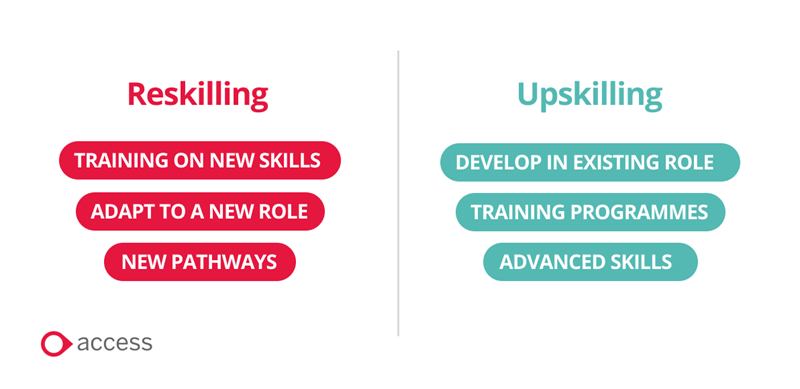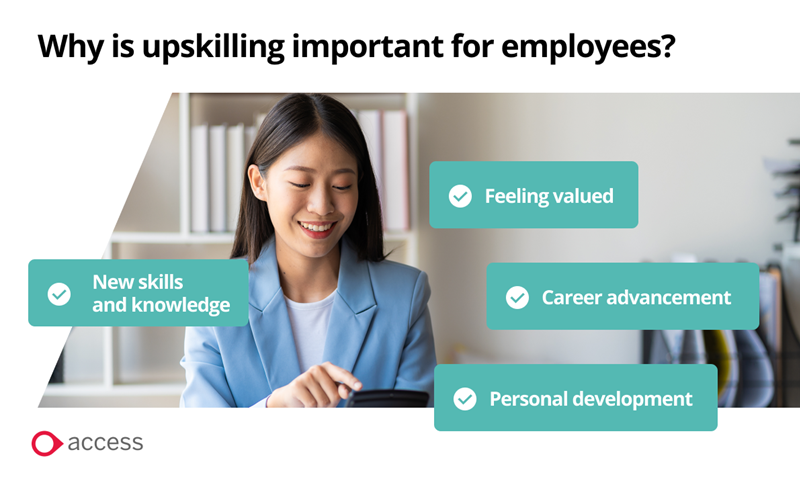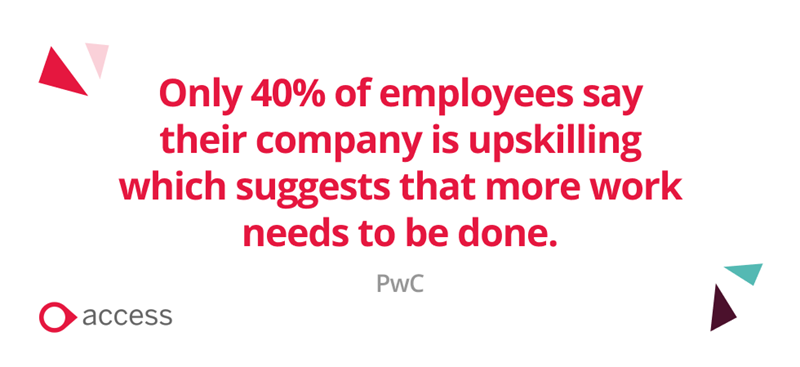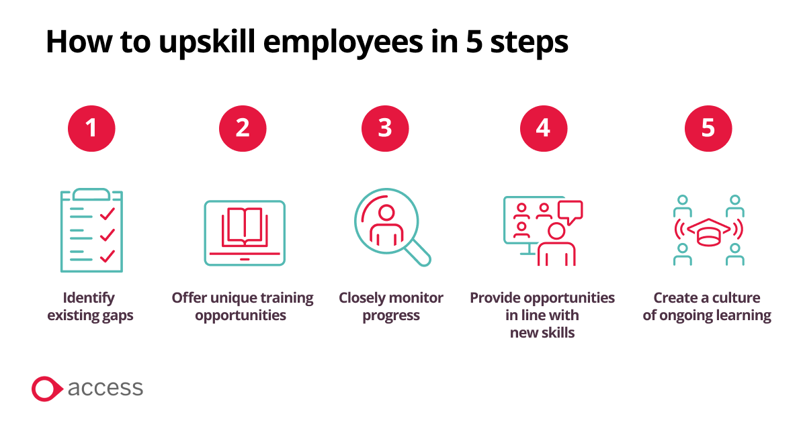-
- Learning Management System
- Learning Management System
- eLearning Courses
- Gamified Learning Solutions
- Content creation software
-
- eLearning Courses
- eLearning Courses
- Compliance eLearning
- Compliance eLearning for Financial Services
- Cyber Security Awareness eLearning
- Health & Safety eLearning
- Mental Health & Wellbeing eLearning
- Workplace Skills and Personal Development eLearning
- Online teaching resources for schools
- Self Directed Learning

What is upskilling and why should your organisation invest in an upskilling strategy?
In this article we are going to explore “What is upskilling?”, the importance of upskilling employees, closing the skills gap and how to put together a robust employee upskilling strategy. We will also discuss the difference between upskilling and reskilling.
 10 minutes
10 minutes
Written by Garry Goldman, Head of Employee Success
With many organisations looking to gain a competitive edge and ensure their workforce operates at its best, it’s no surprise that upskilling has become a vital tool. Making the most of the talent available and upskilling for internal career development and staff retention are key pillars in this initiative.
However, according to a survey carried out by PwC, only 40% of employees say their company is upskilling which suggests that more work needs to be done.
What is reskilling and upskilling?
Now let’s differentiate between upskilling and reskilling. While they share similarities, they are ultimately different in their purpose and results. Upskilling focuses on acquiring additional skills in an existing field, while reskilling involves learning new skills for a different job or industry.
What is upskilling?
Upskilling is the process of offering training programmes and development opportunities to help employees advance and develop their existing skillset. It will give them the tools and knowledge they need to carry out their jobs effectively.
What is reskilling?
Reskilling focuses on preparing an employee for a new role by offering them training on new skills. It aims to enhance an individual's employability and ability to meet evolving demands in the workforce.
Organisations should carefully weigh the options of upskilling and reskilling employees, selecting appropriate times based on individual needs and addressing specific skills gaps within the business. The investment in these upskilling and reskilling initiatives can help to build an adaptable workforce that embraces learning new skills.

Why upskilling is important for employees
Whilst it is not a new concept, recent reports have highlighted the growing importance of an upskilling strategy: addressing the skills gap and investing in both skills that empower employees to thrive in their roles and take charge of their career development should be a priority for Learning and Development (L&D) teams. According to the CPD’s 2022 Resourcing and Talent planning report, nearly two-fifths of organisations are increasing efforts to meet their talent requirements by developing more talent in-house.
Upskilling your employees can offer many benefits, including enabling employee growth and giving them the opportunity to develop a new skill. This will help them to feel valued within the organisation and means they are less likely to look elsewhere for other opportunities. Let’s explore some key advantages that introducing upskilling initiatives can bring for employees and which enable them to flourish in their roles.
1. Employees feel valued
When the workforce is invested in via upskilling, employees understand their worth within the company and feel like they are truly part of the team and not just a cog in the machine. This in turn will boost morale and engagement which can have a positive impact on mental health in the workplace. A recent survey found that those who were supported at work were twice as likely to be happy and almost three and a half times more likely to be flourishing, so this investment in employee development not only enhances professional skills but also contributes to overall wellbeing.
2. Facilitates career advancement
For employees looking to advance their careers, upskilling can offer some great opportunities for development within an organisation. Equipping employees with the skills they need not only to thrive at their current level but also to help support them on their desired career paths with internal movement being key.
3. Personal development
In the Adult Participation in Learning Survey 2023, 25% of adults reported that participating in learning initiatives enhanced the skills crucial for their job, which in turn elevated their self-confidence. This highlights the point that when engaging in targeted learning supported by their organisations, employees will experience a boost in self-confidence and competence. Improving these skills will also help alleviate fears of job security, especially in times of financial crisis. This translates into heightened job satisfaction, as employees recognise their evolving capabilities and the value they bring to their roles.
4. Develop new skills and knowledge
Arguably the most obvious benefit of upskilling is its encouragement for employees to cultivate skills and knowledge they didn't have before. Whether it involves acquiring workplace soft skills to navigate challenging situations, mastering leadership skills, or gaining practical proficiency in specific tools or software programs, employees can develop expertise in areas they are passionate about. This self-directed learning approach empowers individuals to enhance their skill sets and contributes to both personal and professional growth.
5. Staying abreast of digital transformation
Upskilling is essential for staying abreast of digital transformation. As Forbes emphasises, "upskilling entails learning new skills, but it also involves a cultural shift and change management. To be competitive in the digital age, individuals and corporations require a learning-for-life mindset, collaboration—with humans and machines - and a willingness to embrace new ways of doing things." A proactive commitment to continuous learning, collaboration, and adaptability ensures individuals remain agile and are not left behind while digital transformation - and the skills that come with it - continue to evolve.

All too often we find employers doing the bare minimum with staff development and simply hoping their employees will choose to stay for the long-term. Smart businesses see the value of investing in people across all levels of their organisation, making them feel valued and supporting them to be the best they can be at each stage of their career.
Benefits of upskilling for organisations
There are many advantages of upskilling that can bring about positive change to an organisation. Let’s look at five benefits of upskilling employees.
Employee retention
It’s no surprise that when organisations don’t invest in the personal development of their workforce, employees are more likely to look for new roles. In fact, HR News reported that 1 in 4 office workers would leave their current position if offered better opportunities for progression elsewhere.
According to Linkedin’s 2023 Workplace Learning Report, “Progress toward career goals” is the No. 1 motivation for employees to learn. When employees are given the tools and support they need to learn skills and become better at their job, the investment that goes into their development will often result in increased job satisfaction and loyalty, as noted by Gallup. Instead of feeling expendable, they will understand their value and are likely to seek out progression opportunities.
Increases productivity
A recent survey carried out by PwC found that 93% of CEOs with more advanced upskilling programmes saw higher workforce productivity which isn’t overly surprising - an engaged workforce is more productive, and this is where organisations usually see an uplift in discretionary effort.
If an employee has the skills to do their job well and have been given the right training at the right time, then they are more likely to get stuck into tasks without having to worry about learning new skills.
This is particularly true when it comes to practical skills like learning how to use a specific computer programme, but can also be applied to soft skills too. Adapting to changing demands like specific technological updates will boost confidence and likely create better work outputs which in turn, positively impacts the business.
Encourages culture of learning
Upskilling offers organisations a strategic advantage by playing a key role in a transformative culture of continuous learning. As leaders actively participate in and encourage upskilling, they showcase a commitment to growth, reinforcing a culture that is receptive to change.
With 72% of global business leaders recognising the crucial role of culture in successful change initiatives, when leaders actively encourage upskilling it showcases a commitment to growth.
Saves on recruitment costs
While this links to the first point on employee retention, it’s important to note the cost-saving benefits that introducing upskilling initiatives can bring.
Did you know that hiring a new employee can cost a company around £3000? Despite many organisations looking to recruit for the skills they need, it is far more cost-effective to upskill the employees within your organisation.
As organisations grow and employees advance to more senior roles, the gaps that are left can be easily filled when there is strong and highly skilled talent available internally. Building a talent pipeline will save on having to compete in a highly competitive job market for skills that your employees already have.
Offers a competitive edge
Building a workforce that is adaptable to change and keen to stay on top of evolving industry demands will give organisations a strong advantage over competitors.
Learning journeys tailored to employee needs and interests lead to stronger engagement among staff – and companies in the top percentile of engagement see an average of 21% higher profits.
Find out how our Career Development software can transform L&D in your organisation
Upskilling and reskilling to help close the skills gap
When exploring why upskilling is important for employees, it’s crucial to talk about closing the skills gap. We have discussed how to identify and close the skills gap in the workplace in detail within a previous article, noting the following takeaways:
- Bridging the skills gap requires a tailored approach, with a focus on offering diverse training and development opportunities to employees, considering various delivery methods.
- Larger businesses face challenges beyond implementing a learning management system, requiring a more comprehensive strategy to address long-term skills gaps.
- Gen Z is keen on fast career growth and believes learning is key to success, demonstrating a proactive approach to personal development.
- Employers should prioritise a balance between soft and hard skills, hire for attitude, and invest in strategic initiatives such as modern performance management and internal mobility to attract and retain top talent and address skills gaps effectively.
Incorporating these points when you are looking to upskill your employees will help to ensure you are training the right people on topics and skills they will find most beneficial and that will help them do their jobs well.

Developing an upskilling strategy
Once you have established that your organisation and employees can greatly benefit from upskilling, the next step is for the L&D leader to develop a robust upskilling strategy.
A strategic approach to upskilling should:
Utilise organisation-wide skills mapping
Engaging in skills mapping across your organisation is necessary for a successful upskilling strategy. This process entails a detailed analysis of roles critical for business operations, ensuring a clear understanding of evolving skill requirements. Regular updates to these mappings are vital to reflect the dynamic nature of skills.
Recognise that each department and role have different needs
Upskilling employees (and offering training opportunities at any level) can’t work with a one-size-fits all approach. Tailoring upskilling initiatives on both a departmental and individual basis ensures that training aligns with specific job requirements, maximising its impact. From your initial roles and skills mapping, along with the current organisational level priorities and objectives, look at what departments or functions could most benefit from upskilling initiatives.
Look at current requirements alongside a long-term plan
To understand who you should be focussing priority upskilling initiatives at an individual level, you may want to look at working with identified employees to complete skills surveys or assessments and Individual Development Plans, or IDP’s. This document is a personalised resource which helps employees to grow professionally. It will include specific steps which should be taken for them to meet the goals set out within the document. When an organisation utlitises personal development planning in this way, it helps to embed a culture of learning as an ongoing process and not just as and when it is necessary to review.
Embrace technological integration for enhanced efficiency and cost savings
Allocating sufficient resources to support the learning needs of your workforce involves includes dedicating budget and personnel to learning initiatives, ensuring access to essential training materials, and allowing employees the necessary time for engagement in the upskilling process. To enhance the efficiency and cost-effectiveness of this strategy, it is crucial to explore the integration of technology for facilitating learning. Implementing digital learning technologies such as a Learning Management System (LMS) not only streamlines the training process but also enables targeted assignment of relevant learning resources to individuals when needed. An LMS further facilitates accessibility for remote workers, ensuring they can easily access relevant training information, thereby making the overall upskilling initiative more efficient and cost-effective in the long run.
How to upskill employees in 5 steps
Once you have established how you are going to approach upskilling within your organisation, you can work to introduce a framework in which upskilling individual employees can be integrated into your organisation's culture and operations. This section will guide you through a five-step process introduced by the L&D leader that can then be rolled out with supervision by line managers.
1. Identify existing gaps
- Use an IDP on an annual basis to identify where each employee may have gaps in knowledge or skills which would benefit their role, which can then be addressed
- Discuss with the employee and anyone they work closely with, such as a manager or team leader, to identify what may need improvement and what upskilling opportunities are available
- Leverage valuable skills data found within a HR and payroll software suite. This includes performance management and career development tools, both of which provide a single source of truth
2. Offer unique training opportunities
- Provide the most relevant types of digital learning such as online courses, webinars and gamified learning to create a blended learning approach that most suits the employee
- Encourage the 70/20/10 learning model which suggests that 70% of learning comes from on-the-job experience, 20% through learning from others and 10% is gained with the help of formal learning methods
- Ensure training is fully accessible for those working remotely and for those with other specific accessibility needs
3. Closely monitor progress
- Implement regular check-ins to ensure that your employees are progressing well
- Ask for feedback to identify areas where additional support may be needed
- Establish key performance indicators (KPIs) to measure the impact of the upskilling initiative
4. Provide opportunities in line with new skills
- Align work and responsibilities with the skills being developed
- Foster mentorship programmes to encourage knowledge transfer and practical application
- Encourage employees to participate in cross-functional projects to apply and reinforce their newly acquired skills
5. Create a culture of ongoing learning
- Encourage a mindset of continuous learning that does not just stop when the task has been ticked off
- Recognise and reward employees for their commitment to upskilling initiatives and the positive outcomes that come along with it
- Build a collaborating workforce where learners feel empowered to share knowledge and seek out their own learning opportunities
- Offer targeted learning experiences through role-specific learning paths that get pushed out whilst also providing self-serve opportunities via an extensive library of resources

Upskill your employees with Access Learning
Now we have discussed how upskilling can benefit your employees and the wealth of advantages it can also bring to your organisation, let’s recap how Access Learning can help you with the process.
- Utilising a Learning Management System (LMS) will help you deliver the right training at scale, making it easy for employees to develop new skills and knowledge.
- A Career Development platform can enable individuals to understand their personal skills gaps and help you create suitable Individual Development Plans to ensure training is tailored and targeted to meet the specific goals of each learner.
- Using unified recruit-to-retire HR software will give you a clear overview of your people data and make filling any upskilling gaps simpler.
- A comprehensive catalogue of eBooks, live virtual classrooms, audiobooks and online courses will offer a complete blended learning experience suited to the preferences of your workforce. Our self-directed learning platform encourages a self-guided training approach which further facilitates the upskilling initiative.
